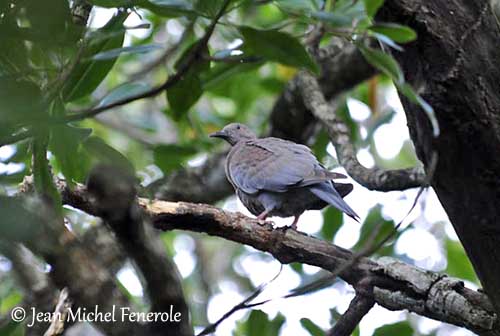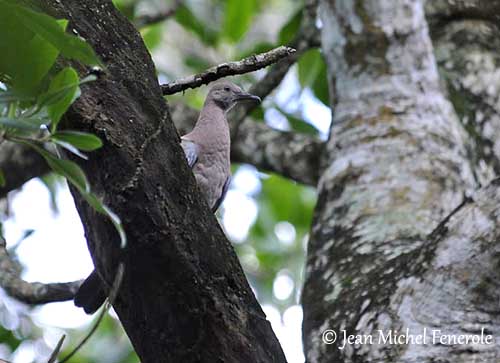
Fr: Pigeon simple
Ang: Plain Pigeon
All: Rosenschultertaube
Esp: Paloma Boba - Paloma sabanera (Puerto Rico)
Ita: Colomba disadorna
Nd: Wijnrode Duif
Sd: Karibisk duva
Photographer:
Jean Michel Fenerole
Photos d’Oiseaux du monde
Text by Nicole Bouglouan
Sources:
HANDBOOK OF THE BIRDS OF THE WORLD vol 4 by Josep del Hoyo-Andrew Elliott-Jordi Sargatal - Lynx Edicions - ISBN: 8487334229
PIGEONS AND DOVES by David Gibbs, Eustace Barnes and John Cox - Pica Press Sussex - ISBN: 1873403607
BirdLife International (BirdLife International)
Wikipedia, the free encyclopaedia
Center for Biological Diversity
Plain Pigeon
Patagioenas inornata
Columbiformes Order – Columbidae Family
INTRODUCTION:
The Plain Pigeon is today a Near Threatened species due to habitat fragmentation and heavy hunting pressure. In addition, the hurricanes often affect the islands where it occurs.
In spite of protection throughout the range, the populations are very small. Captive breeding programmes are underway in Puerto Rico, in order to release the birds in the wild.
This species was formerly found in all wooded habitats, but due to the deforestation, it is found now in other type of environment.
DESCRIPTION OF THE BIRD:
Biometrics:
Length: 39-41 cm
Weight: 250-365 g
The adult of nominate race has deep maroon to vinaceous head, neck and breast to lower belly. Flanks, undertail-coverts, rump and uppertail-coverts are bluish-grey.
Back, scapulars, tertials and innermost wing-coverts are brown with white margins. The tail is dark grey to black on both sides.
On the head, the forehead is greyer whereas the crown is slightly darker.
The long, thin bill and the cere are black. The eyes are greyish-white to bluish with orange outer ring. The eyering is greyish to greyish-purple. Legs and feet are dark red.
The female has paler and duller plumage.
The juvenile is browner and duller, paler below. We can see pale edges to wing-coverts and breast feathers.

SUBSPECIES AND RANGE:
The Plain Pigeon has three subspecies.
P.i. inornata (described and displayed) is found in Cuba, Hispaniola and Isle of Pines.
P.i. exigua occurs in Jamaica. This race is the darkest of all races. It has white eyes surrounded by red orbital skin.
P.i. wetmorei is found in Puerto Rico. This one is darker overall than nominate. The white edges on the wing-coverts are broader than in other races.
HABITAT:
The Plain Pigeon frequents primary and secondary rainforests, pinewoods, dry coastal desert, desert thorn-scrub, mangroves, montane forests, open country and patches of farmland and pastures.
This species may occur from sea-level to high elevations in its native habitat.
CALLS AND SONGS: SOUNDS BY XENO-CANTO
The Plain Pigeon’s common calls are a growling “rrrrrroooooo” and a “ca-c-ooooo”.
The song is a simple “cuck-caooo, cuck-caooo, cuck-caooo” or “cuck, ca-ooo”.
BEHAVIOUR IN THE WILD:
The Plain Pigeon has wide diet including seeds, fruits, berries, leaves, buds and flowers, depending on the range and the food resources.
This species is mainly arboreal when foraging, although it may occasionally come to the ground.

The Plain Pigeon is usually found in small groups, but outside the breeding season, larger flocks can be formed, especially for feeding. In Jamaica, they perform daily upland to lowland movements to find food.
There is no information about the courtship displays, but we can suggest that they are fairly similar to the typical behaviour of other Columbidae, with courtship flight, bowing and cooing.
They may nest fairly close to each other in loose associations instead of true colonies.
The Plain Pigeon is resident in its range, with only daily altitudinal movements to feed.
The flight is fast and powerful, with active wingbeats.
REPRODUCTION OF THIS SPECIES:
The breeding season varies according to the range. The Plain Pigeon can breed all year round in Puerto Rico, with a peak of activity from December to June. It breeds between April and July in Cuba and Hispaniola.
The nest is a flimsy platform made with twigs. It is placed in tree or shrub, usually in mangroves, pines and hardwoods. In Puerto Rico, they often nest in bamboo patches or tall trees in canyons. They may nest in loose association.
The female often lays 2 white eggs (a single egg in Puerto Rico). Both adults incubate during 13-15 days (18 days in Puerto Rico). The young fledge 21-23 days after hatching.
PROTECTION / THREATS / STATUS:
The Plain Pigeon is threatened by hunting pressure, deforestation, degradation of the habitat by clearance for agriculture expansion, and hurricanes.
This species is rare in Cuba and still quite common in Haiti. There is a small population in Dominican Republic, and good numbers in Puerto Rico where a recovery programme is underway with 40-50 birds.
The global population is currently estimated at about 2,000 individuals and slowly declining.
The Plain Pigeon is currently classified as Near Threatened.